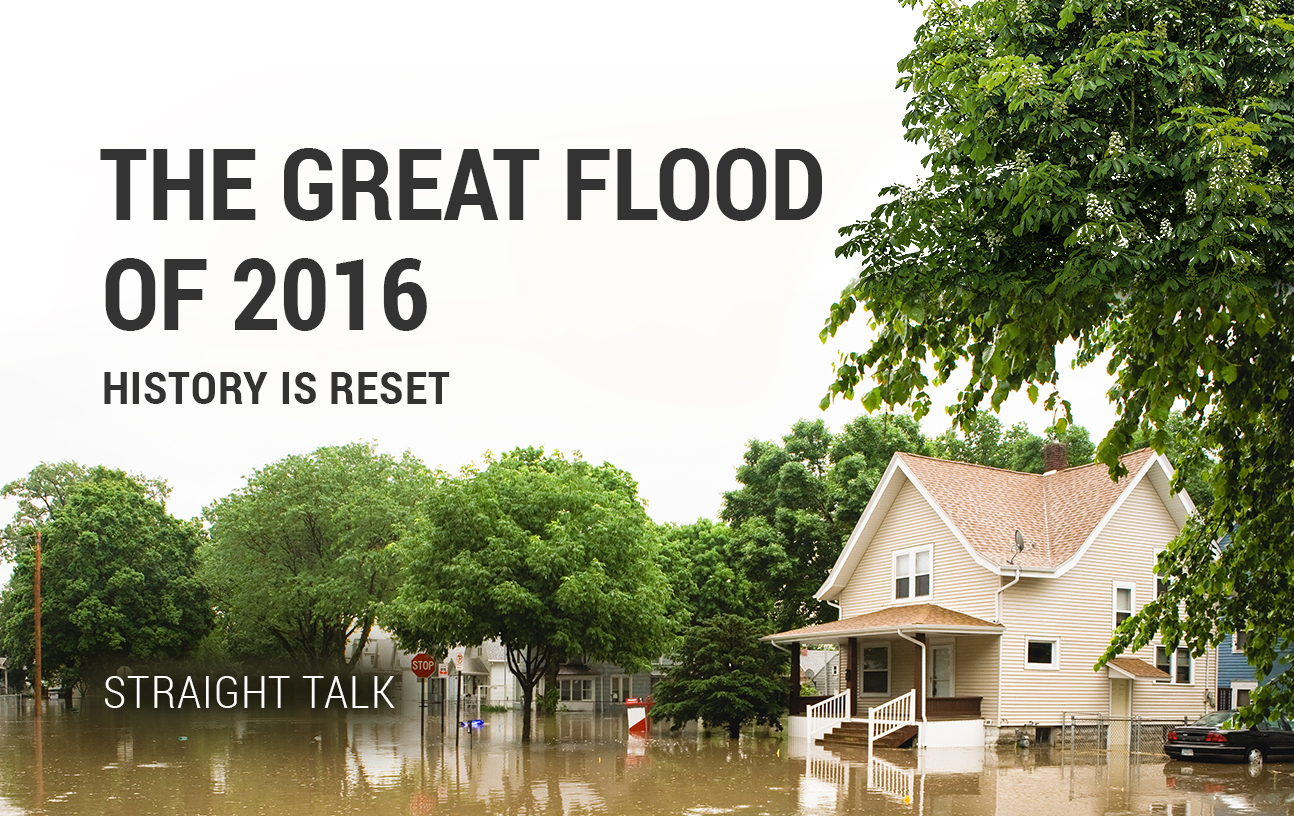I just can’t wrap my brain around these numbers (even after 55 years of living in South Louisiana).
In about 48 hours, 6.9 TRILLION gallons of rain fell on an area roughly 50 miles wide (east/west) and 30 miles long (north/south). This was enough to cover the whole area with 24 inches of water. By my calculations, enough water to fill the Superdome from the field to the top of the dome more than 10,000 times. Six CUBIC MILES of water. How else can I express how much rain this is?
First, let’s be clear: No drainage system on earth could have handled that much water in so short a time without changing the landscape a lot. Some spots within that zone, had 31 inches of rain in less than three days! Our average ANNUAL rainfall here is about 60 inches. So this area received six months of rain in two days.
In the Great Flood of 2016, areas 20 or 30 feet ABOVE sea level flooded.
As I sit here writing this, that water has mostly moved on south and most flooded areas are starting to dry out.
Now our challenges are different. Now we must reset history, and resetting history will be hard work. And we cannot do it alone.
In the Great Flood of 2016, areas 20 or 30 feet ABOVE sea level flooded. Carefully designed rainwater drainage systems around the state that had handled many inches of rain at a time and performed flawlessly for 40 years or more began running BACKWARDS and flooded areas that have not flooded in recorded history. This means tons of people got surprised. I can’t tell you how many people I ran across, working in shelters and mucking out houses, who said the same thing: “I don’t flood at my house. I mean, it never has before!”
The National Weather Service in New Orleans has river stage records that go back decades for the Amite River near my home. The highest level in those records was 14.6 feet, recorded in 1983. That same river in that same spot stopped rising on Monday, Aug. 15, at 2 p.m. at 18.5 feet!
Without more federal aid, we in East Baton Rouge Parish, Livingston Parish and Ascension Parish will face whole blocks of property with nothing but ruined, abandoned housing.
More than 100 years of records smashed by 30%. History must be RESET. And Louisiana cannot do that alone.
We as a nation have to change our thinking a bit now. Resetting history is never easy or cheap.
The financial losses are just starting to be tallied, but since most of the property that flooded was far above the (brand-new Federal Emergency Management Agency – FEMA) 100-year flood line, or was older property that had been in families for generations, many of the people whose homes and businesses were damaged will not be covered by flood insurance. That’s a reality we must deal with going forward. The level of federal assistance available for homeowners who are not insured must increase. There is no precedent for this, and the poor were absolutely hit the hardest.
Non-governmental assistance has been a powerful force so far. Across the nation, churches, universities, civic groups and private residents have been pouring early-stage resources into our area. God bless each and every one of them! I personally unloaded a truck from a tiny church in Dauphin Island, Alabama, this weekend FULL of cleaning supplies like buckets, gloves, mops and bleach, all things that were in short supply locally. The private sector’s assistance is booming here right now.
But this is a very big job, and in times of trouble, we look to the government for assistance. FEMA is here, busy and on the ground, but they are statutorily limited and cannot give any uninsured homeowner more than $33,000 in maximum grants, and in reality, the grants will be much lower than that. In Katrina, the average non-insurance grant was about $8,000. When you start thinking about the materials and labor it will require to make a house with just a few inches of water in it even livable again, that grant cannot scratch the surface.
(M)edia reports indicated that more than 110,000 houses in a 20-parish area took on water, with a net property value exceeding $20 billion, without a named storm or hurricane to blame. The scale now rivals hurricanes Katrina and Rita, which flooded 134,000 houses in the New Orleans area in August and September 2005.
Without more federal aid, we in East Baton Rouge Parish, Livingston Parish and Ascension Parish will face whole blocks of property with nothing but ruined, abandoned housing. Even today in New Orleans, 11 years after Katrina, there are sections of the city that remain undeveloped. A huge amount of our low-cost housing was destroyed. Where will the poor live, if the federal government doesn’t step in? How will that low-cost housing be replaced?
The state already had a well-documented budget shortage before this tragedy. State agencies were cutting back, universities are ramping up tuitions and fees, and still the state had a shortage. We cannot look to the state treasury to repair this damage. The numbers are just too big.
This week, media reports indicated that more than 110,000 houses in a 20-parish area took on water, with a net property value exceeding $20 billion, without a named storm or hurricane to blame. The scale now rivals hurricanes Katrina and Rita, which flooded 134,000 houses in the New Orleans area in August and September 2005.
This process of resetting history must begin with our Congressional delegation and the support of the federal treasury. Because of the unexpected and unprecedented nature of this flood, we need to reset the history of disaster relief to ensure that the poor can find safe, clean and dry places to settle.
The last thing we need are low-income folks “winging it” and trying to move back into damaged housing, there to deal with mold, mildew and the illnesses that follow. In this storm with no name, few houses were actually “washed away;” most were flooded with from a few inches to eight feet or more of water, and only for a couple of days. Their electricity is back on and people are starting to try to move back in even before carpets are ripped out and saturated walls replaced.
Without proper funding and proper remediation, these people will be moving back into a lifetime of illness and pain, in previously flooded houses that were not cleaned properly. They deserve better than that, and unfortunately only the federal treasury has the resources to ultimately solve that problem.
Until they do, we Louisianans will keep on working. We’ll keep mucking out our friends’ houses, running all over to buy the essentials to donate to shelters and distribution points. We’ll keep studying the event, the way the water moved, and coming up with solutions to put this new learning to work. We will keep living here, but we will live smarter and safer, now that we’ve seen a new level of flooding.
We will reset history in Louisiana. We need the federal government to do the same.





Telling it like it is! !!!!
Well written and so enlightening.